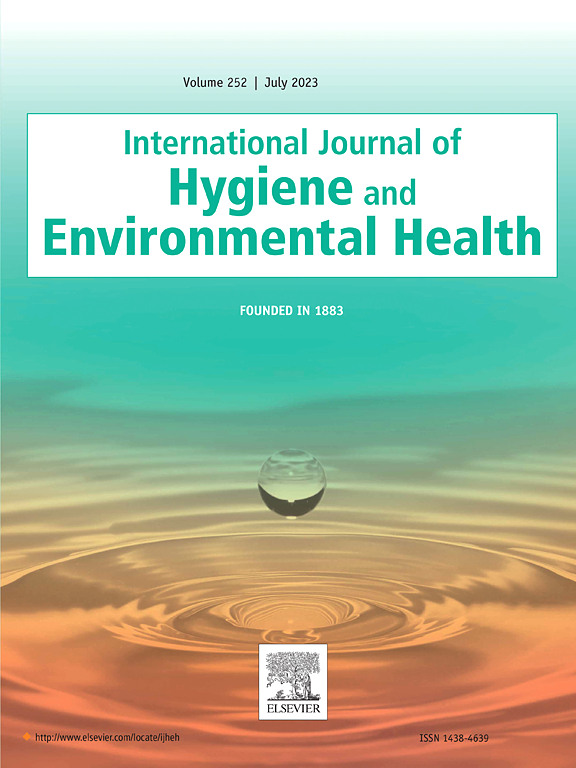美国军事人员持久内分泌干扰化学物质的血清浓度:种族/民族和性别的比较
IF 4.4
2区 医学
Q1 INFECTIOUS DISEASES
International journal of hygiene and environmental health
Pub Date : 2025-02-19
DOI:10.1016/j.ijheh.2025.114540
引用次数: 0
摘要
目的/背景我们根据种族/民族(R/E)和性别评估了美国军队样本中内分泌干扰化学物质(EDCs)的血清浓度模式,即多氯联苯(PCBs)、有机氯农药(OCPs)和多溴联苯醚(PBDEs)。方法对1995 ~ 2010年美国国防部血清库708名现役军人血清样本进行23项EDCs检测。对于每个EDC,使用线性回归模型中的对数转换浓度估计了八个混合R/E/性别组的几何平均值(GM):非西班牙裔白人(NHW),非西班牙裔黑人(NHB),非西班牙裔亚洲人(NHA)和西班牙裔男性和女性,根据年龄和服务部门进行调整,并按年龄分位分层(“年轻”:17-23岁,“中年”:24-30岁,“老年”:31-52岁)。将我们的军队样本与2003-2004年NHW和NHB组的国家健康和营养检查调查(NHANES)数据进行比较。结果在我们的军队样本中,PCB浓度最高的是老年NHB男性和女性,OCP浓度最高的是老年NHB女性和NHA男性。尽管样本量较小,但多溴二苯醚浓度在中年西班牙裔女性和NHA男性中普遍最高。一般来说,NHB男性和女性在军队和NHANES中都有较高的EDCs浓度。结论:我们发现军队样本中NHB、NHA和西班牙裔人群以及NHANES中NHB男性和女性中EDC浓度升高的模式。没有一致的模式较高或较低的EDCs比较军队和NHANES。未来对EDC和健康结果的研究应按性别/性别进行分层,以解释EDC浓度的潜在差异。本文章由计算机程序翻译,如有差异,请以英文原文为准。
Serum concentrations of persistent endocrine-disrupting chemicals in U.S. military personnel: A comparison by race/ethnicity and sex
Objectives/background
We evaluated patterns of serum concentrations of endocrine disrupting chemicals (EDCs), namely polychlorinated biphenyls (PCBs), organochlorine pesticides (OCPs), and polybrominated diphenyl ethers (PBDEs), in a U.S. military sample by race/ethnicity (R/E) and sex.
Methods
Twenty-three EDCs were measured in stored serum samples obtained between 1995 and 2010 for 708 service members from the Department of Defense Serum Repository. For each EDC, geometric means (GM) were estimated using log-transformed concentrations in a linear regression model, for eight combined R/E/sex groups: non-Hispanic White (NHW), non-Hispanic Black (NHB), non-Hispanic Asian (NHA), and Hispanic men and women, adjusted for age and service branch and stratified by age tertile (“younger age”: 17–23, “middle age”: 24–30, and “older age”: 31–52 years). Comparisons were made between our military sample and the National Health and Nutrition Examination Survey (NHANES) 2003–2004 data for NHW and NHB groups.
Results
Within our military sample, the highest PCB concentrations were among older age NHB men and women and highest OCP concentrations among older age NHB women and NHA men. PBDE concentrations were generally highest in middle age Hispanic women and NHA men, though based on small sample size. Generally, NHB men and women had higher concentrations of EDCs in both the military and NHANES.
Conclusions
We found patterns of elevated EDC concentrations among NHB, NHA, and Hispanic groups in the military sample and for NHB men and women in NHANES. There were no consistent patterns of higher or lower EDCs comparing the military to NHANES. Future studies of EDCs and health outcomes should stratify by R/E/sex to account for potential disparities in EDC concentrations.
求助全文
通过发布文献求助,成功后即可免费获取论文全文。
去求助
来源期刊
CiteScore
11.50
自引率
5.00%
发文量
151
审稿时长
22 days
期刊介绍:
The International Journal of Hygiene and Environmental Health serves as a multidisciplinary forum for original reports on exposure assessment and the reactions to and consequences of human exposure to the biological, chemical, and physical environment. Research reports, short communications, reviews, scientific comments, technical notes, and editorials will be peer-reviewed before acceptance for publication. Priority will be given to articles on epidemiological aspects of environmental toxicology, health risk assessments, susceptible (sub) populations, sanitation and clean water, human biomonitoring, environmental medicine, and public health aspects of exposure-related outcomes.

 求助内容:
求助内容: 应助结果提醒方式:
应助结果提醒方式:


